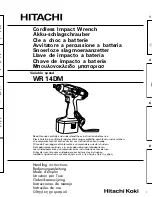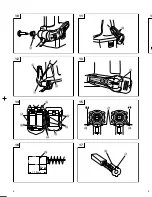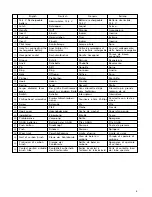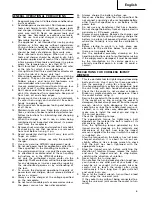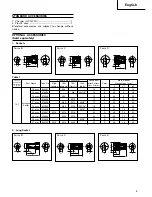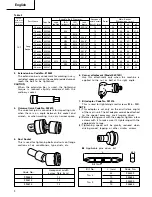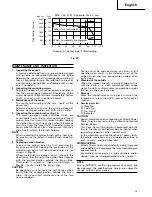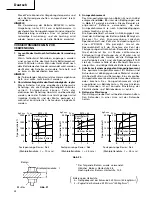
11
English
4. Disconnect the charger’s power cord from the
receptaele
5. Hold the charger firmly and pull out the battery
NOTE
After charging, pull out batteries from the charger
first, and then keep the batteries properly.
Regarding electric discharge in case of new batteries,
etc.
As the internal chemical substance of new batteries
and batteries that have not been used for an
extended period is not activated, the electric
discharge might be low when using them the first
and second time. This is a temporary phenomenon,
and normal time required for recharging will be
restored by recharging the batteries 2 – 3 times.
How to make the batteries perform longer.
(1) Recharge the batteries before they become
completely exhausted.
When you feel that the power of the tool becomes
weaker, stop using the tool and recharge its battery.
If you continue to use the tool and exhaust the
electric current, the battery may be damaged and
its life will become shorter.
(2) Avoid recharging at high temperatures.
A rechargeable battery will be hot immediately after
use. If such a battery is recharged immediately after
use, its internal chemical substance will deteriorate,
and the battery life will be shortened. Leave the
battery and recharge it after it has cooled for a
while.
CAUTION
䡬
If the battery has been heated right after operation
(or due to sunlight, etc.), the charger’s pilot lamp
may not light in red. In such a case, first let the
battery cool, then start charging.
䡬
When the pilot lamp flickers in red quickly (at 0.2-
second intervals), check for and take out any foreign
objects in the charger’s battery installation hole. If
there are no foreign objects, it is probable that the
battery or charger is malfunctioning. Take it to your
Authorized Service Center.
䡬
Since the built-in micro computer takes about 3
seconds to confirm that the battery being charged
with UC14YFA is taken out, wait for a minimum of
3 seconds before reinserting it to continue charging.
If the battery is reinserted within 3 seconds, the
battery may not be properly charged.
PRIOR TO OPERATION
1. Preparing and checking the work environment
Make sure that the work site meets all the conditions
laid forth in the precautions.
2. Checking the battery
Make sure that the battery is installed firmly. If it
is at all loose it could come off and cause an
accident.
3. Selecting the socket matched to the bolt
Be sure to use a socket which is matched to the
bolt to be tightened. Using an improper socket will
not only result in insufficient tightening but also in
damage to the socket or nut.
A worn or deformed hex. or square-holed socket
will not give an adequate tightness for fitting to the
nut or anvil, consequently resulting in loss of
tightening torque.
Pay attention to wear of socket hole, and replace
before further wear has developed.
Finally, install the socket prescribed in Item 4. The
section on “Optional Accessories” details the
relationship between bolt sizes and sockets. Sockets
are named according to the dihedral width of the
hexagonal hole.
4. Installing a socket
Select the socket to be used.
䢇
Pin, O-ring type (
Fig. 4
and
5
)
(1) Align the hole in the socket with the hole in the
anvil and insert the anvil into the socket.
(2) Insert the pin into the socket.
(3) Attach the ring to the groove on the socket.
䢇
Plunger type (
Fig. 6
)
Align the plunger located in the square part of the
anvil with the hole in the hex. socket. Then push
the plunger, and mount the hex. socket on the anvil.
Check that the plunger is fully engaged in the hole.
When removing the socket, reverse the sequence.
HOW TO USE
1. Using the convenient hook
The convenient hook can be installed on the right
or left side and the angle can be adjusted in 5 steps
between 0
°
and 80
°
.
(1) Operating the hook
(a) Pull out the hook toward you in the direction
of arrow (A) and turn in the direction of arrow
(B) (
Fig. 7
).
(b) The angle can be adjusted in 5 steps (0°, 20°,
40°, 60°, 80°).
Adjust the angle of the hook to the desired
position for use.
(2) Switching the hook position
CAUTION
Incomplete installation of the hook may result in
bodily injury when used.
(a) Securely hold the main unit and remove the
screw using a slotted head screwdriver or a coin
(
Fig. 8
).
(b) Remove the hook and spring
(Fig. 9
).
(c) Install the hook and spring on the other side and
securely fasten with screw (
Fig. 10
).
NOTE
Pay attention to the spring orientation. Install the
spring with larger diameter away from you (
Fig. 10
).
(3) Using as an auxiliary light
(a) Press the switch to turn off the light.
If forgotten, the light will turn off automatically
after 15 minutes.
(b) The direction of the light can be adjusted within
the range of hook positions 1 - 5 (
Fig. 11
).
䡬
Lighting time
AAAA manganese batteries: approx. 15 hrs.
AAAA alkali batteries: approx. 30 hrs.
CAUTION
Do not look directly into the light.
Such actions could result in eye injury.
Summary of Contents for WR 14DM
Page 2: ...4 9 D E A 1 2 3 5 6 7 8 9 1 2 1 6 3 2 1 4 5 9 0 A C A B 9 1 7 8 F A B 5 4 3 2 1 G ...
Page 3: ...10 11 2 12 13 14 15 3 16 17 18 H I F J K L F N M O P O N L R Q R R S 3mm 11 5mm T U ...
Page 4: ...3 18 19 V ...
Page 88: ...87 ...
Page 90: ...89 1 2 3 4 5 ...
Page 91: ...90 ...
Page 92: ...91 ...
Page 93: ...92 ...

